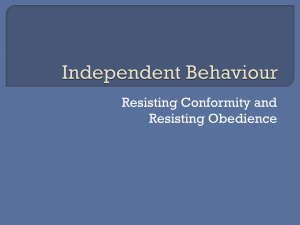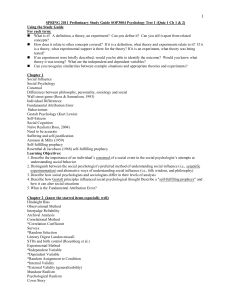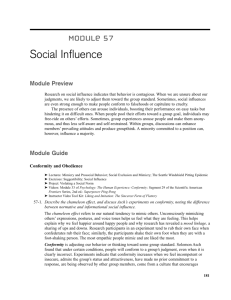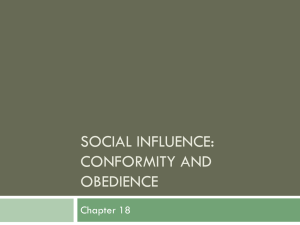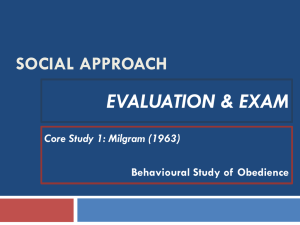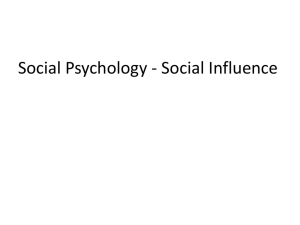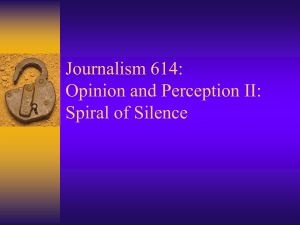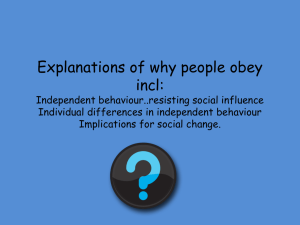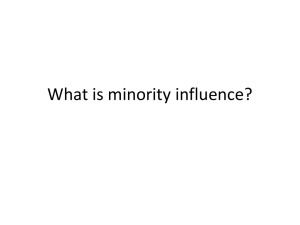Explanations of majority influence
advertisement
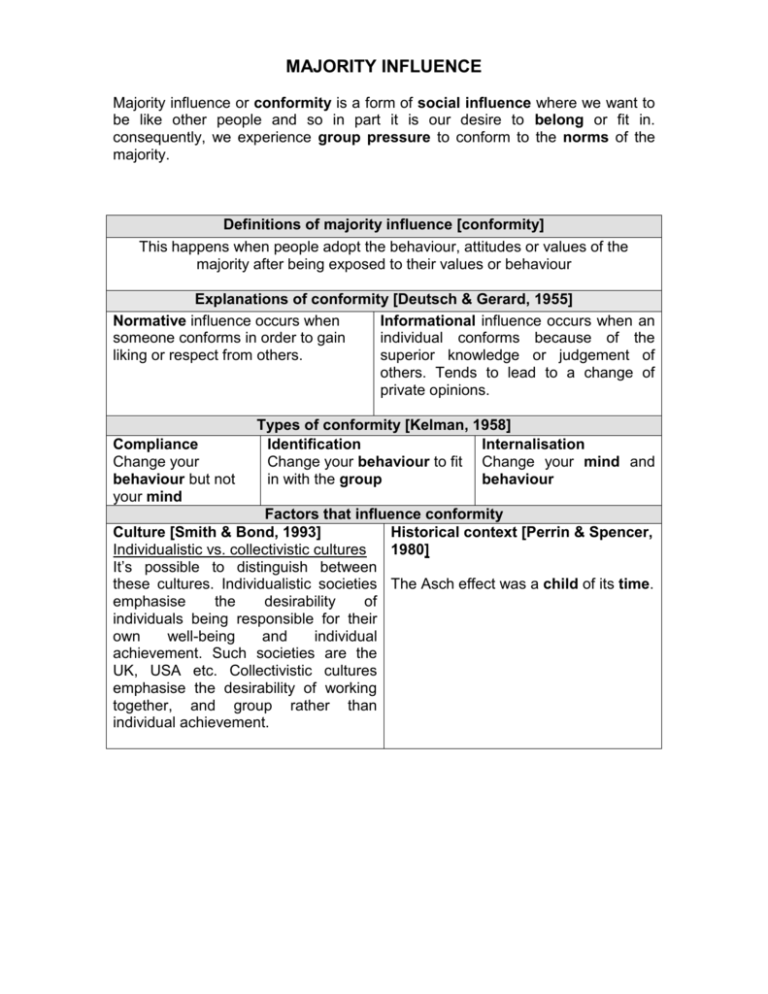
MAJORITY INFLUENCE Majority influence or conformity is a form of social influence where we want to be like other people and so in part it is our desire to belong or fit in. consequently, we experience group pressure to conform to the norms of the majority. Definitions of majority influence [conformity] This happens when people adopt the behaviour, attitudes or values of the majority after being exposed to their values or behaviour Explanations of conformity [Deutsch & Gerard, 1955] Normative influence occurs when Informational influence occurs when an someone conforms in order to gain individual conforms because of the liking or respect from others. superior knowledge or judgement of others. Tends to lead to a change of private opinions. Compliance Change your behaviour but not your mind Types of conformity [Kelman, 1958] Identification Internalisation Change your behaviour to fit Change your mind and in with the group behaviour Factors that influence conformity Culture [Smith & Bond, 1993] Historical context [Perrin & Spencer, Individualistic vs. collectivistic cultures 1980] It’s possible to distinguish between these cultures. Individualistic societies The Asch effect was a child of its time. emphasise the desirability of individuals being responsible for their own well-being and individual achievement. Such societies are the UK, USA etc. Collectivistic cultures emphasise the desirability of working together, and group rather than individual achievement. MINORITY INFLUENCE Group pressure can be resisted as this is what occurs when people yield to minority influence as first they must have rejected the majority norm. The many real life examples of minority influence show its potential to bring about reform. The process by which the minority influences the majority is called conversion. People often conform with the majority whilst privately they are critiscing the position of the minority. Definitions of minority influence A majority being influenced by to accept the beliefs. Explanations of majority influence Conditions for conversion Social impact theory [Latane & Wolf, [Moscovici, 1985] 1981] is a general explanation of social influence that also explains Consistency The minority must be consistent in their majority influence. view or opinion. Strength This is determined by the numbers of Flexibility people or the strength of the message. The minority must not appear to be rigid or dogmatic Status and knowledge The greater the status and knowledge, Commitment the fewer people will be needed to A committed minority will lead people persuade. to rethink their position. This is a compliance, not a conversion. Immediacy The closer you are to the influence, the Relevance greater the effect will be. The minority will be more successful if their views are in line with social trends Differences between majority and minority influence Majority influence Minority influence Compliance Conversion Immediacy Takes place over time High need for approval Lower need for approval OBEDIENCE Definitions of obedience to authority Behaving as instructed, usually in response to individual rather than group pressure. This usually takes place in a hierarchy where the person issuing the order has higher status than the person obeying. Obedience occurs because the individual feels they have little choice – they can’t resist. It is unlikely to involve a change in private opinion. Explanations of obedience Agentic state – a situational factor Authoritarian personality – a personal factor Differences between obedience and conformity Obedience Conformity Social influence is based on Social influence is based on hierarchy. equal status Explicit Implicit Participants embrace obedience as an explanation of their behaviour Participants deny conformity as an explanation of their behaviour METHODOLOGICAL CRITICISMS OF MILGRAM’S RESEARCH Definitions of experimental validity The extent to which research has internal and external validity. Definitions of ecological validity The validity of the research situation itself; the extent to which the findings are generalisable to other situations, especially ‘everyday’ situations. Experimental validity Evidence for experimental realism Evidence provided by Milgram eg video tapes Participant’s reactions Evidence against experimental realism Demand characteristics Ecological validity Evidence for experimental realism Milgram’s variations in a run down office Cross-cultural replications Further studies eg Hofling et al [1966] and Bickman [1974] Generalisability to the Nazi atrocities of Holocaust Evidence against experimental realism lacks mundane realism limited generalisability to current setting the ecological validity of the further studies can be questioned Conclusions There are persuasive arguments for and against the validity of Milgram’s research. His research has many weaknesses. However, the findings are still important as the research participants’ belief that they were delivering electric shocks supports experimental realism and so ecological validity. Furthermore, the findings illustrated the fundamental attribution error, which is the tendency to underestimate the role of situational factors and overestimate the role of personal factors. Milgram’s conclusion that the situational context was highly influential has been applied to the atrocities of the Holocaust, which demonstrates the general and thus ecological validity of the research. Resistance to Obedience Milgram (1974) carried out many variations of his original remote-victim experiment. Two factors increased resistance to obedience. In the box below, write down the obedience percentages for each variation to see how much obedience reduced and resistance increased. Also, write down some details about the different variations. What is your comparison percentage (ie., Milgram’s original finding)? Reducing the influence of the experimenter Originally, 65% increased the voltage past 450 volts. Location of the experiment = 48% when the experiment was set in a run down office building rather than Yale University, there was less obedience. Orders by telephone = 20.5% A disobedient role-model = 10 % people felt more comfortable saying no if someone else was Increasing the obviousness of the learner’s distress Voice feedback 62 % Proximity ---- 1 metre away = 40% Touch-proximity --- hand on shock plate = 30 % Milgram’s (1963) study of obedience to authority For: yes, the end justify the means Against: no, the ends do not justify the means Methodological justifications – Ethical issues. validity/importance of the findings. Participants’ comments on their experience. Critics of the research. Were ethical issues resolved. Ethical issues that remain unresolved.
